| Handel's Acis and Galatea: Mozart, Mendelssohn, and Performance
Practices of the Eighteenth and Nineteenth Centuries 2 |
| 音楽エッセイのページへ戻る | 初期多声音楽 | St.マーシャル楽派へ |
| Leoninのページへ | ノートルダム楽派(conductus)のページへ |
ペロタン(Viderunt Omnes) |
| ペロタン(Alleluja Nativitas) | ペロタン Clausulaのページ | まうかめ堂さんのページへ |
| substitute clausulaのページへ | 中世音楽のページへ | |
| Chapter 4
Mendelssohn’s Acis und Galatea In terms of Felix Mendelssohn’s association with early music, scholars identify him as one who was responsible for bringing about a revival of the sacred choral music of J.S. Bach. While the revival of Bach’s choral music is a watershed moment in his career and reputation with respect to being a conductor and champion of early music, it is not the first encounterhe had with the music of the Baroque. Just prior to the Bach revival, Mendelssohn made an adaptation of Handel’s Acis and Galatea in the winter of 1828, and the Berlin Singakademie performed it in January 1829. Between its inaugural performance and rediscovery in 2005, little had been known about this adaptation. Mendelssohn’s interest in the music of Handel has yet to be thoroughly researched. With the emergence of a first edition copy of Mendelssohn’s adaptation in 2005, we now have access to this part of Mendelssohn’s work.117 What follows is a brief study of the score and an illumination of the historical context in which Mendelssohn made the adaptation of Handel’s Acis and Galatea. フェリックス・メンデルスゾーンの初期の音楽との関連において、学者は彼を、J.S.の神聖な合唱音楽の復活をもたらした責任を負う者として認識する。バッハの合唱曲の復活は、初期の音楽の指揮者としてチャンピオンとして尊敬される彼のキャリアと名声の分水嶺であると言えるが、(バッハとの出会いは彼の)バロックの音楽との最初の遭遇ではない。バッハの復活の直前にメンデルスゾーンは、1828年の冬、ヘンデルの「 Acis and Galatea 」の改訂を行い、1829年1月にBerlin Singakademieが演奏した。その初演と2005年の再発見の間に、この改訂についてはほとんど知られていなかった。メンデルスゾーンのヘンデル音楽への関心は、まだ完全には研究されていない。 Mendelssohnの2005年版の初版の登場により、メンデルスゾーンのこの作業にアクセスできるようになった.メンデルスゾーンが「 Acis and Galatea 」の改訂を成し遂げた歴史的な過程のスコアの簡単な研究を以下に示す。 In this chapter, I will provide an overview of Mendelssohn’s early musical training, his apprenticeship with Carl Friedrich Zelter and the Berlin Singakademie, his engagement with Handel adaptation in light of his efforts to revive the music of J.S. Bach, the background to his adaptation of Handel’s Acis and Galatea, and finally an analysis of said adaptation. この章では、メンデルスゾーンの初期音楽の訓練の概観をおこない、Carl Friedrich Zelter とthe Berlin Singakademieの師弟関係や、バッハ音楽のリヴァイヴァルと関連しての彼のヘンデル編曲の取り扱い、改訂の背景、そして最後に編曲自身の分析を試みたい。(略) The Performance of Adaptations of Handel’s Music and the Berlin Singakademie The reception Handel’s music received in German-speaking countries in the first quarter of the nineteenth century was driven by the formation of choral societies.123 In Vienna there was the Gesellschaft der Associierten and performances of arrangements were held in conjunction with a music festival. Between the 1810s and the1820s, the music festival culture was widely responsible for the performance of older music, often Handel’s choral music.124 Much of what choral societies performed were Handel’s English oratorios. Messiah, Acis and Galatea, Israel in Egypt, Ode for St. Cecilia’s Day, Alexander’s Feast, and Judas Maccabaeus comprised a “narrow circle of about six so-called principal works.”125 What often occurred when adapting a Handel oratorio, the libretto was translation into German and the orchestration augmented.126 19世紀の第1四半期にドイツ語圏で受け入れられたヘンデルの音楽の受容は、合唱団の形成によってもたらされた。 ウィーンではGesellschaft der Associiertenがあり、音楽祭と並んで、編曲作品の演奏が行われた。 1810年代と1820年代の間に、音楽祭文化は、古い音楽、しばしばヘンデルの合唱音楽のパフォーマンスに広く関与していた。 choral societyが演奏した作品の多くは、ヘンデルの英語のオラトリオであった。 「Messiah」, 「Acis and Galatea」,「 Israel in Egypt」, 「Ode for St. Cecilia’s Day」, 「Alexander’s Feast」, 「Judas Maccabaeus 」は、「6つのいわゆる主要作品の狭いサークル」を構成していた。ヘンデルのオラトリオの編曲がしばしば行われると、リブレットがドイツ語に翻訳され、オーケストレーションが強化された。 Along with organizing a choral society came the expectation of the artistic directors to perform the music in the style and with the instruments of his time. This required music directors, such as Zelter and their assistants, such as Mendelssohn, to make adaptations of Handel’s music. In light of this, “it was typical of the performance practice of that time to use arrangements of the oratorios, for instance by Mozart, and Ignaz von Mosel; particularly preferred were the ‘big three’: Messiah and Alexander’s Feast (both arrangements by Mozart), and JudasMaccabaeus (possibly in the arrangement of Starzer).”127 The Berlin Singakademie, between the years 1807 and 1832, performed Messiah twice, Judas Maccabaeus four times, and Mendelssohn’s arrangements of Handel’s Dettingen Te Deum, and Acis and Galatea each once.128 合唱団を組織するとともに、芸術監督が彼の時代の楽器やその様式の音楽を演奏することが期待されるようになった。ヘンデルの音楽を採用していくためには、はZelterや彼の助手、メンデルスゾーンのような人材が求められた。 これに照らして、「モーツァルトや Ignaz von Moselなどのオラトリオの改訂を使うのは、その時代の演奏の典型であった。 特に Messiah and Alexander’s Feast (both arrangements by Mozart), and JudasMaccabaeus (possibly in the arrangement of Starzer)のようなビッグ・スリーが特に好まれた」127。Berlin Singakademieは、1807年から1832年にかけて、メサイアを2回、Judas Maccabaeusを 4回、メンデルスゾーン編曲のヘンデルのDettingen Te Deumと「AcisとGalatea」をそれぞれ1回ずつ行なった。 The Berlin Singakademie was an environment full of musical exposure to mid-eighteenth century music. Carl Fasch (1736-1800), who had conducted the society since its founding in 1791, programed older music as part of the academy’s performance season. 129 When Zelter took over the helm of the organization in 1800, he continued the tradition of presenting older music. In addition to being a significant part of the early music revival in Germany, the Singakademie maintained a substantial music library. Moses Mendelssohn had acquired some of J.S. Bach’s manuscripts and donated them to the library.130 This collection facilitated the academy’s ambition to program the music of Handel and Bach. Berlin Singakademieは、18世紀半ばの音楽への音楽的発露でいっぱいの環境であった。 1791年の創立以来、この組織を司るCarl Fasch(1736-1800)は、アカデミーのパフォーマンスシーズンの一環として、より古い音楽のプログラムを組んだ。 Zelterが1800年に組織の舵取りを引き継いだとき、彼は古い音楽を発表するという伝統を続けた。Singakademieは、ドイツの初期の音楽復活の重要な組織であったのに加えて、実質的な音楽ライブラリーを維持していた。 Moses MendelssohnはJ.S.バッハの作品のいくつかを所持していた。 そして、バッハの遺稿をライブラリーに寄贈した。このコレクションは、ヘンデルとバッハの音楽をプログラム化するためのアカデミーの野望を容易にした。 The circumstances leading up to the performance of Bach’s Matthaus-Passion (BWV 244) includes Mendelssohn’s intentional study of and attempts at mimicking late Baroque music. In 1826, Mendelssohn composed a Te Deum. The following year, he wrote seven character pieces for solo piano (Op. 7), which included fugal movements, contrapuntal imitation, essences of early piano sonata in the slow movements, and dance-like rhythmic motives. This opus gave way to his polychoral motet, Hora est, in 1828. In this year, he developed an affinity for writing music of older, more established genres. Both the Te Deum and Hora est harkened back to a former time of florid counterpoint, and formulaic templates.131 Even his motet Jesu meine Freude(1828) makes reference to the famous motet by Bach. These compositions indicate that during his studies with Zelter and the Singakademie, Mendelssohn strengthened his capacity to integrate his compositional voice while drawing on music of specific genres that were popular in eighteenth century.132 Bachのマタイ受難曲(BWV 244)のパフォーマンスにつながる状況には、後期バロック音楽を模倣するためのメンデルスゾーンの意図的な調査や試みが含まれている。 1826年、メンデルスゾーンはTe Deumを作曲した。翌年、彼は、フーガ楽章、対位法的模倣、緩徐楽章中の初期のピアノソナタのエッセンス、ダンスのようなリズミカルな動機などを含む、ソロピアノのための「7つの性格的な作品」(Op.7)を書いた。この作品は、1828年の複合唱モテット「Hora est」へのさきがけとなるものであった。この年、メンデルスゾーンは、より古くてすでに確立されたジャンルの音楽を書くことへ親しみを感じるようになった。Te Deum と Hora estの両者は、昔の華麗な対位法や定式化された雛形への郷愁であった。彼のモテットであるJesu meine Freude(1828)も、バハの有名な同名のモテットを参照している。これらの作品は、Zelter と the Singakademieとの勉強の間の時期のものである。メンデルスゾーンは、18世紀に人気のあった特殊な分野の音楽を書きながら、彼の作曲スキルを磨くよ努めていたのである。 The revival of Bach’s Matthaus-Passion is a watershed moment in Mendelssohn engagement with older music. The first performance of the passion since around the time of its premiere took place in Berlin, with choruses performed by the Singakademie. In 1825, when Mendelssohn was sixteen years old, his grandmother gave him a score of Matthaus-Passion. Over the next three years, Mendelssohn prepared to conduct the auspicious revival. The performance took place in March 1829 and was Mendelssohn’s debut as a conductor of early music.133 Donald Mintz comments, “there came along a young man whose strivings made a stir because they seemed so unusual, who did not inquire about the doings in Paris and Italy-indeed he sometimes even went right past Mozart and Haydn-but thereby investigated all the more diligently the works of Handel and Bach.”134 What Mintz crystallizes is Mendelssohn’s aptitude for assimilating the music of Bach and Handel. Furthermore, Mendelssohn’s adaptations of these composers’ music advances the notion that he was a kind of conservator of older music. バッハのマタイ受難曲の復活は、メンデルスゾーンの古い音楽との関わり合いの分水嶺である。受難曲の最初の演奏は、Singakademieで演奏された合唱で、ベルリンで行われた。メンデルスゾーンが16歳だった1825年、彼の祖母はマタイ受難曲のスコアを与えた。その後3年間、メンデルスゾーンは非常に重要な復活演奏を行う準備をした。演奏は1829年3月に行われ、それは、最初の指揮者としてのメンデルスゾーンのデビューだった。Donald Mintzは、「若い男がやってきた。かれは普通ではない非常なる努力をした。彼はパリやイタリアでの行動については調査しなかった、確かに時々モーツァルトやハイドンを過ぎて行ったが、ヘンデルやバッハの作品については非常によく研究していた」とコメントしている。 Mintzがまとめたことは、バッハやヘンデルの音楽へ一体化する、メンデルスゾーンの才能である。さらに、メンデルスゾーンによるこれらの作曲家の音楽の改訂は、彼が古い音楽の一種の保守者であるという考えを推し進める。 The 1829 performance of Bach’s Matthaus-Passion forever fused Mendelssohn with Baroque music revival. In order to perform the passion in the nineteenth century, Mendelssohn adapted Bach’s score. He augmented the instrumentation and updated some of the instrumental parts with instruments that were more commonly played in the early nineteenth century. For instance, the baritone solo, “Komm sussess Kreuz” includes a viola da gamba obbligato, which had to be transcribed for cello. Making this and other alterations to the score was crucial to the success of the 1829 revival performance. バッハのマタイ受難曲の1829年の演奏は、メンデルスゾーンとバロック音楽の復活を永遠に融合させた。 19世紀に受難曲の演奏を果たすために、メンデルスゾーンはバッハのスコアに大幅に手を入れた。彼は器楽を増強し、19世紀初めより一般的に演奏されるようになった楽器で楽器の一部を更新した。例えば、バスのソロ "Komm sussess Kreuz"には、viola da gamba のobbligatoが含まれているが、これはチェロに移し変えられた。 1829年の復活の成功のためには、このように、スコアに変更することが不可欠であった。 Mendelssohn’s adaptations of Handel’s music include an English oratorio, a canticle, a masque, and a coronation anthem. The success of Mendelssohn’s revival of Bach’s passion overshadows his involvement with adapting some of Handel’s more prominent compositions. In all, Mendelssohn makes adaptations of ‘Dettingen’ Te Deum, Acis and Galatea, Israel in Egypt (1833) Zadok the Priest (1836) and organ parts for the overtures of Solomon (1834), and Joshua (1835), and two choruses from Messiah. Three of the aforementioned scores are large-scale, vocal works. Except for the cantata Gottes Zeit ist die allerbeste Zeit (BWV 106), these adaptations are mostly reorchestrations of a sampling of Bach’s keyboard works for either organ or violin. Compared to his adaptations of Handel’s music, these transcriptions are not as elaborate, nor are they of genres such as oratorio, opera, or choral anthem. Modern reception of Mendelssohn’s capacity to synthesize older music focuses on the Bach revival. He did indeed create more adaptations of Handel’s music than he did of Bach’s. メンデルスゾーンのヘンデル音楽への改訂には、英語のオラトリオ、カンティクル、マスク、戴冠式アンセムが含まれる。メンデルスゾーンのバッハのマタイ受難曲の復活演奏が成功したことは、ヘンデルの著名な作品のいくつかを編曲した彼の役割を覆い隠してしまっている。メンデルスゾーンは、‘Dettingen’ Te Deum, Acis and Galatea, Israel in Egypt (1833) Zadok the Priest (1836) そして organ parts for the overtures of Solomon (1834), Joshua (1835), two choruses from Messiahを編曲しているのである。最初の3作品が、大規模な、合唱作品である。カンタータGottes Zeit ist die allerbeste Zeit(BWV 106)を除き、こうした編曲は、ほとんどが、オルガンやバイオリンのためのバッハの鍵盤作品のサンプリングを再オーケストレーションしたものである。ヘンデルの音楽の編曲と比較して、これらの写譜は、精巧なものではなく、オラトリオ、オペラ、または合唱アンセムのようなジャンルのものでもない。メンデルスゾーンの古い音楽を統合する能力への現代の見方は、バッハの復活に焦点を当てている。しかし彼は、実際には、バッハの編曲よりも、ヘンデルの音楽のより多い編曲を行っていたのである。 Mendelssohn’s Adaptation of Handel’s Acis and Galatea Mendelssohn edited Handel’s score for a performance in Berlin in 1831 with the Berlin Singakademie under the direction of Carl Zelter.135 The score on which Mendelssohn based his adaptation was the first edition printed by John Walsh in London in 1743.136 The most significant change from the Walsh score to the Mendelssohn edition was the translation into German of the English libretto by Pope, Pepusch, and Gay. Mendelssohn and his sister worked on the translation together. As far as adapting the music, Mendelssohn, compared to Mozart, was rigorous in adding instrumental parts, omitting movements, and adding measures to Handel’s music. メンデルスゾーンは、1831年のベルリンでのパフォーマンスのために、Berlin Singakademie のCarl Zelter指示のもとでヘンデルのスコアを編纂した。メンデルスゾーンが編曲の際に用いたスコアは、、1743年にロンドンのJohn Walshが印刷した初版であった。メンデルスゾーン版のWalshのスコアからのもっとも重大な変更は、Pope, Pepusch, and Gayによる英語リブレットのドイツ語への翻訳であった。 メンデルスゾーンと彼の妹は一緒に翻訳に取り組んだ。 音楽に関しては、Mendelssohnはモーツァルトと比較して、楽器を追加したり、楽章を省略したり、ヘンデルのスコアに小節を加えたりした。 Mendelssohn retains the concise nature of Handel’s Cannons score. The 1743 first edition printing of Handel’s Acis and Galatea does divide the score into two sections with the phrase, “end of the first part.”137 But this is not an accurate representation of the Cannons version, which did not include a choral reprise of the preceding duet.138 The 1718 version of the score lacks any distinction of act or scene. The duet “Happy we” immediately precedes the chorus “Wretched lovers” in this version. However, Mendelssohn does bisect the score between the chorus, “Happy we” and “Wretched lovers” by marking “Ende des 1. Teils” (“End of the 1st Part”) after the former and “Zweiter Teil” (“Second Part”) at the top of the first page of “Unglucksel’ge, das Geschick” (“Wretched Lovers”). The result is two sets of choruses that bookend each part. Mendelssohn structures his adaptation in this way so it remains compact, while allowing for a clean break between sections. This demarcation might be a subtle difference, but many of the movements in Mendelssohn’s version are unmistakably altered. メンデルスゾーンは、ヘンデルのCannonsスコアの簡潔な性質を残している。 Handelの「AcisとGalatea」の1743年の初版では、「第1部の終わり」というフレーズで2つのセクションに分けられている。しかしこれは、先立つ二重唱の後を受ける合唱を含んでいないために、Cannons版の正確な再現ではない。 1718年のCannons版は、幕や場面の区別がない。この版では、二重唱“Happy we”が合唱“Wretched lovers”の直前にある。しかし、Mendelssohnは前者の後に "Ende des 1. Teils"(「第1部の終わり」)と前者の後の「Zweiter Teil」(第2部)をマーキングすることにより、合唱“Happy we”と「Wretched lovers」の間のスコアを二分した。その結果、各パートを亜両脇からはさむ2組のコーラスが得られる。メンデルスゾーンはこのように編曲を構造化しているため、、コンパクトなままでありながら、セクション間をきれいに分割することができている。この区分けは微妙な違いかもしれないが、メンデルスゾーン版の楽章の多くはミスなく変更されている。 In examining Mendelssohn’s edition of Acis and Galatea, I will again model my analysis on Schildkret’s analytical method. First, however, I will illustrate the changes in instrumentation between the intimate one-on-a-part orchestration for the Cannons instrumentalists and the much larger orchestra of the Berlin Singakademie. メンデルスゾーンの「AcisとGalatea」の版を調べるにあたり、私はSchildkretの分析方法に関する分析を再度モデル化する予定である。 最初に、私は、Cannonsの楽器奏者のための親密な1対1のオーケストレーションと、Berlin Singakademieのもっと大きなオーケストラとの間の楽器の変化を説明する。 The musicians of the Singakademie were a blend of semi-professional and amateur performers in both the main choir and the orchestra.139 The choir boasted a roster of around twenty-five singers per part, and the orchestra would have resembled the size of a typical Beethovenian ensemble with around forty string players, a dozen woodwind players, and a handful of brass players. There are two considerations Mendelssohn made when adapting Handel’s Acis and Galatea that were motivated by the limitations of the Singakademie. One was the ability of the performers to read and interpret some of the obscure notation of Handel’s score. The other was producing a score that contemporary musicians could have played using the instruments from around 1830. Handel’s scoring included a violin I part, violin II part, a recorder part in two movements, two oboe parts, and parts for basso continuo instruments.140 Since Mendelssohn was adapting the music for an orchestra that was considerably larger and more varied in instrumentation, most of the movements had to be reorchestrated and new music written for additional instruments. Singakademieの音楽家たちは、合唱、オーケストラ共に、セミプロとアマチュアの混合であった。合唱団は各パートごとに約25人の歌手の名簿をもち、オーケストラは典型的なベートーヴェン風の構成で、およそ40人の弦楽器、12人の木管楽器奏者、そして少数の金管楽器奏者から成っていた。Singakademieの能力限界によって課せられた、ヘンデルの Acis and Galatea」を編曲する際に、メンデルスゾーンが考えざるを得なかった2つの制約がある。 1つは、演奏家がヘンデルのスコアのあいまいな表記を読譜し、解釈する能力であった。もう一つは、1830年頃の楽器の使い方に合ったスコアを作り出すことであった。ヘンデルの曲は1stバイオリン、2ndバイオリン、2つの楽章で使われるのリコーダーパート、2つのオーボエパートを含んでいた140。メンデルスゾーンは、かなり大きく変化したオーケストラの音楽を改訂していたため、ほとんどの楽章を再オーケストレーションしなければならず、追加の楽器のために新しい音楽を書き直さなければならなかった。 140 The development of the modern flute, oboe, and stringed instruments occurred rapidly during the hundred years between Handel’s time in Cannons and Mendelssohn’s living in Berlin. These changes alone made a remarkable impact on the sound of the music and afforded Mendelssohn the opportunity to compose instrumental parts that Handel would have been unable to compose due to the limits of the instruments. This mainly occurs during the movements when brass and timpani join the woodwinds and strings. 近代フルート、オーボエ、弦楽器は、ヘンデルとメンデルスゾーンの間の100年間に急速に発展した。 これらの変化は、音楽に顕著な影響を及ぼし、メンデルスゾーンは、ヘンデルが楽器の限界ゆえに作曲できなかった器楽パートを作曲する機会を得ていた。これは主に、金管楽器とティンパニが木管楽器と弦楽器に加わるときの動きの間に発生する。 Mendelssohn reorchestrates every movement of Handel’s Acis and Galatea. As far as adding instrument parts, Mendelssohn writes for two modern flutes, two clarinets, viola, two bassoons, trumpets, horns, timpani, and serpent.141 Mendelssohn would have had an orchestra comprised of about thirty stringed instruments, a dozen woodwinds, and a small group of brass instruments including corno inglese di basso as shown in Example 4.1. The addition of violas is most noticeable in the recitative accompaniment found in the second act of Mendelssohn’s score. In measure 7 of the dual recitative “Willst du, Schonste” in which a trio of violas and cello counter-balance the giant’s vocal line as shown in Example 4.2. Mendelssohn incorporates the viola throughout the score and fills in the harmony―a typical aspect in making an adaptation of a mid-eighteenth-century score. メンデルスゾーンは、ヘンデルの「Acis and Galate」aのあらゆる楽章を再オーケストレーションすることとなった。 Mendelssohnは、楽器を追加するにあたり、2つのモダンフルート、2つのクラリネット、ビオラ、2つのバスーン、トランペット、ホーン、ティンパニ、およびセルパンのためのパートを作曲している141。 Mendelssohnは約30の弦楽器、12の木管楽器、 例4.1に示されているように、イングリッシュバスホルンを含む金管楽器グループを構成した。 ヴィオラの追加は、メンデルスゾーンのスコアの第2部で見られるレシタティーボでもっとも注目が行くべきものである。 レシタティーボ“Willst du, Schonste”の7小節にわたって、ビオラとチェロのトリオが、例4.2に示されているように、大規模な声楽部分と対になっている。メンデルスゾーンは、ヴィオラをスコア全体に取り入れ、和声を充実させ、18世紀半ばのスコアを(同時代に)適応させる典型的な側面を示している。 141 The serpent was the lowest brass instrument in Mendelssohn’s score, and he paired it with the vocal utterances of the giant character, Polyphemus. This instrument adds to the dramatic effect of the augmented instrumentation because of its prevalence during the movements that reference or include Polyphemus. For a clearer depiction of the instrumentation of Mendelssohn’s Acis und Galatea, note the table entitled “Instrumentation of Acis and Galatea in Three Versions” in the Appendix. セルパンは、メンデルスゾーンのスコアでは、もっとも低い金管楽器であった。彼はそれをPolyphemusの性格をしめすために使った。この楽器は、Polyphemusを含む楽章に跋扈することにより、増加した器楽の効果にドラマ性を付け加える。 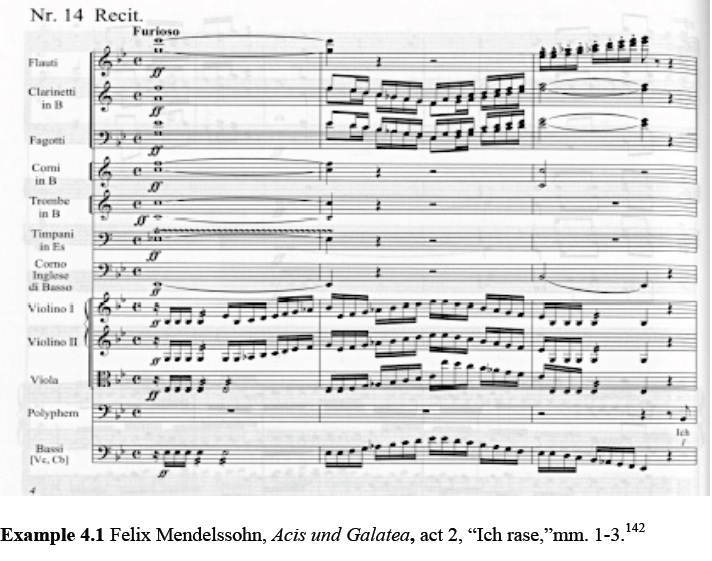 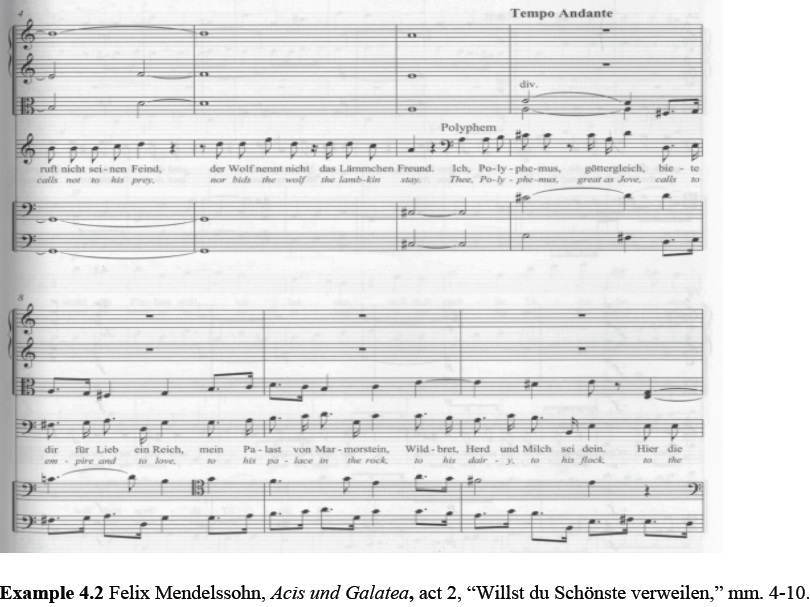 As discussed above, the expansion of the breadth and depth of the orchestra offered Mendelssohn more instrumental color and sound. In the first half of the adaptation, Mendelssohn offers three distinct orchestrations. The following movements are of particular interest because they are varied in instrumentation and offer a contrast in sonic color. They are Galatea’s aria, “Schweig, oh luft’ ger Sangerchor,” (“Hush ye pretty warbling quire”), Galatea’s aria with chorus “Muss ich dem Teuren Klage weihn” (“Must I my Acis still bemoan”), “Hilf Galatea” (“Help Galatea”), and the duet and final chorus, “Selig Gluck” (“Happy we”). Mendelssohn departs the most from the Handel score in these movements. In order to encapsulate a discussion of adapting early eighteenth-century instrumentation in the 1820s, I will hone in on the novelty of each of these four movements. 上で議論したように、オーケストラの幅と深さの拡張により、メンデルスゾーンは楽器の音色をより多く提供した。 編曲の前半では、メンデルスゾーンは3つの区別されたオーケストレーションを提供している。 以下の楽章は特に興味深い。なぜなら、楽器配置で変化し、音色のコントラストを提供するからである。 それは以下の楽章である。 ①Galatea’s aria, “Schweig, oh luft’ ger Sangerchor,” (“Hush ye pretty warbling quire”), ②Galatea’s aria with chorus “Muss ich dem Teuren Klage weihn” (“Must I my Acis still bemoan”), “Hilf Galatea” (“Help Galatea”) ③ duet and final chorus, “Selig Gluck” (“Happy we”) メンデルスゾーンは、これらの楽章の中で、ヘンデルのスコアを最大限に逸脱している。 1820年代の、18世紀初期の器楽の状況についての議論をカプセル化するために、私はこれら4つの楽章のそれぞれの新しさに着目したい。 The first point in my exploration of the differences between the scores is Mendelssohn’s cuts and additions. There are three significant alterations Mendelssohn makes to the score.144 The most considerable deletion is the removal of Galatea’s aria, “As When the Dove,” because “this was of little appeal in a dramatic context.”145 Other than this, Mendelssohn retains everyother movement as it appears in the 1743 score, but he alters the form of the remaining arias. Mendelssohn discontinued the da capo returns as well as omitted the B-section of three arias. Damon’s “Sieh, torichter Schafer,” (“Consider, fond shepherd”) Polyphemus’s aria “Wohl das Flehen will ich lassen,” (“Cease to beauty”) and Acis’s “Lieb’in den Blicken wohnet” (“Love in her eyes”) are all truncated; however, none of these arias end abruptly. Instead, the orchestral parts offer a final ritornello that serves as a kind of coda. By declining to observe the da capo return practice, Mendelssohn significantly changes the flow and structure of the overall oratorio. He also composes additional music in a couple movements that change the phrasing. In order to magnify this aspect of Mendelssohn’s arrangement, I return to the duet/chorus “Selig Gluck.” スコア間の差を調べる最初のポイントは、メンデルスゾーンのカットと追加である。メンデルスゾーンがスコアに与える3つの大きな変更がある144 。最も重要な削除は、ガラテア・アリアの「“As When the Dove,”」の削除である。なぜなら、これは「劇的な内容ではほとんどアピールしなかった」からである。このアリア以外では、メンデルスゾーンは1743年版で現れるようなそれぞれの楽章は残している。だが、アリアの形は変えている。ダ・カーポを中止し、3つのダ・カーポアリアのABAパターンのBセクションを省略した。 Polyphemusのアリア「Wohl das Flehenはlassen」、「Acis」の「Lieb'in den Blicken wohnet」(「彼女の目の中の愛」)、Damonの「Sieh、torichter Schafer」 ")のそのBセクションはすべて切り捨てられている。しかし、これらのアリアはどれも突然終了はしない。代わりに、オーケストラのパートは、一種のコーダとして機能する最後のリトルネルロを提供している。ダ・カーポを中止することによって、メンデルスゾーンは全体のオラトリオの流れと構造を大きく変える。彼はまた、フレーズの変更がある一組の楽章“Selig Gluck.”に追加の音楽を作曲している。メンデルスゾーンの編曲のこの側面をクローズアップするために、このデュエット/コーラス“Selig Gluck.”に戻ってみよう。 144 Handel borrowed it from a similar aria “Wa Wunder, dass ser Sonnen Pracht, which is nearly the same except it is not in ternary form and the violin obbligato is conspicuously missing from the former selection. ヘンデルは、ガラテア・アリアの「“As When the Dove,”」を同様のアリア “Wa Wunder, dass ser Sonnen Pracht”(訳者注;ブロッケス受難曲中のアリア)から借用しているが、それはトリオ形式ではなく、そしてヴァイオリンオブリガートを欠いていることを除いて、ほとんど同じである。 The duet/chorus, “Selig Gluck” (“Happy we”), seen in Example 4.3, epitomizes the adaptive approach Mendelssohn took. By adding new musical material, orchestrating for more instruments, and adapting the musical markings, the final movement of the first section is a well blended example. The most conspicuous change in the duet/chorus movement is Mendelssohn’s halving the meter from 12/8 to 6/8. Furthermore, he modified the rhythmic activity-- retaining the rapid eighth note drive in only the viola and cello parts. First, Mendelssohn changed the time signature so as to assert a conspicuous feeling of the meter in two, rather than preserving the four-beat pulse, which has a larger feeling of two. Second, the duet in the Handel score is a da capo, whereas in the Mendelssohn score the return to the A-section is accomplished by an attacca into the chorus. For the most part, the subsequent chorus contains identical phrasing and harmonic structure as the A-section of the duet. With the addition of wind instruments, horns, and timpani, the opening ritornello is transformed into a wave of sound in which a couple parts maintain the characteristic jig obbligato, or two groups of triplet eighth-notes. 例4.3に見られるデュエット/コーラス「Selig Gluck」(“Happy we”)は、メンデルスゾーンが取った編曲的アプローチの典型を示している。新しい音楽素材を追加し、より多くの楽器をオーケストレーションし、音楽マーキングを付加させることで、第1部の最終楽章はよく混合された例になる。デュエット/コーラスの動きの中で最も顕著な変化は、メンデルスゾーンが拍子を12/8から6/8にしていることである。さらに彼は、リズムの動きを修正している。ビオラとチェロのパートだけで8分音符の速い動きを維持した。最初に、メンデルスゾーンは、2つの感覚がより高い4拍子を維持するのではなく、2拍子の音律の目立つ感情を主張する拍子記号へと変更した。次に、ヘンデルのスコアのデュエットはダ・カーポであるが、メンデルスゾーンのスコアではAセクションへのリターンは合唱へのアタッカによって達成されている。大部分において、後続の合唱は、デュエットのAセクションと同じフレージングとハーモニー構造を含んでいる。管楽器、ホーン、ティンパニの追加により、オープニングリトネルロは、特徴的なジーグ・オブリガート、または3連符の8分音符の2つのグループを持つ音の波に移っていく。 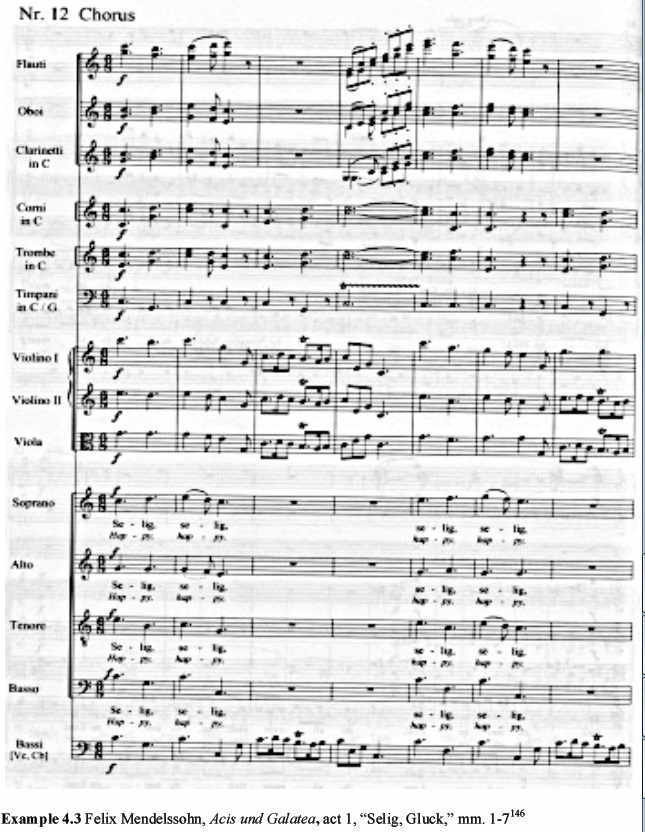 Moving now to another slight alteration in the instrumental parts, the punctuated accompaniment motive in the b-section of the duet “Selig Gluck” (“Happy we”) as shown in Examples 4.4 and 4.5 is altered from an eighth note followed by a quarter note to a motive where an extra quarter note precedes the eighth note-quarter note pattern in measure83. The result is an orchestral chord that occurs on the downbeat (in 6/8) rather than on the anacrusis to the tenth beat (in 12/8). It is possible that when Mendelssohn changed the meter, special accommodation had to be paid to this motive. 器楽パートの別の若干の変更について見てみると、例4.4と4.5に示すデュエット "Selig Gluck"( "Happy we")のbセクションの句読点的伴奏の動機は、8分音符とその後の4分音符が来るパターンから、第83小節の、8分音符に4分音符のパターンが先行する動機に注意したい。その結果、12/8拍子における10番目の拍にたいして、6/8拍子のダウンビートが発生する状況となる。それは、メンデルスゾーンがこの部分の音律を変化させた時に、この動機に特別な順応がなされるべきであった可能性があるのである。 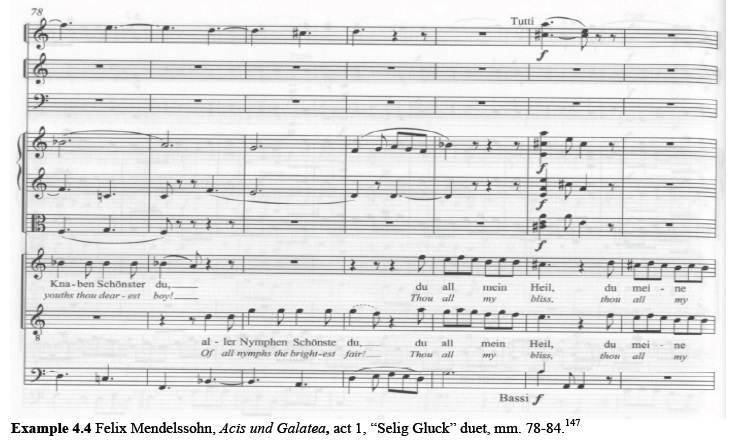 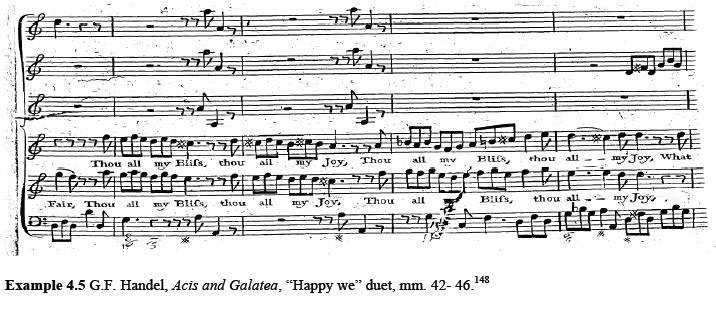 However, because the chord occurs on the downbeat, the words “Lust” (“bliss”) in measure85 and “Heil” (“joy”) in measure 99 are accentuated as shown in Examples 4.6 and 4.7. Additionally, Mendelssohn changes the texture of the instrumental parts at the opening of the Bsection, beginning in measure73. The bass line foreshadows the cascading motion of the solo oboe by absorbing the compound pulses into a strict, simple meter feel, from 6/8 to 2/4. しかし、和音がダウンビートで発生するので、第85小節の “Lust” (“bliss”) と第99小節の “Heil” (“joy”)は、例4.6および4.7に示すように強調される。さらにMendelssohnは、第73小節の最初から、Bセクションのオープニングで器楽パートの肌理を変更する。バスラインは、オーボエソロの下降音型を予兆するかのように厳密に複合パルスを吸収しながら6/8から実質2/4へ、単純な音律となる。 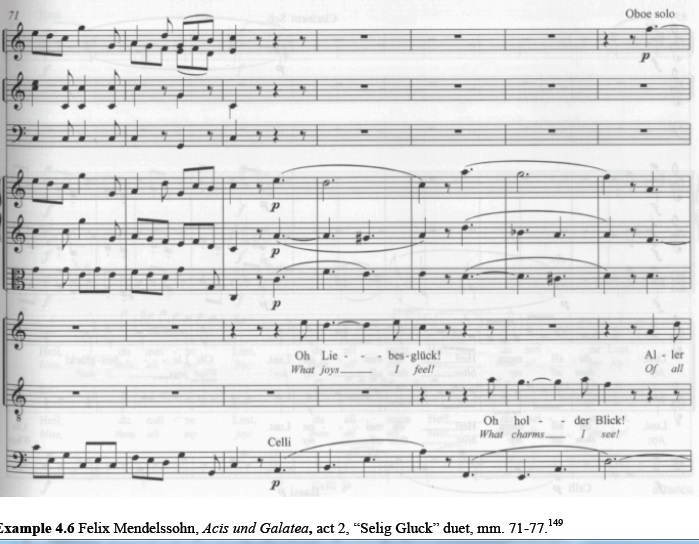 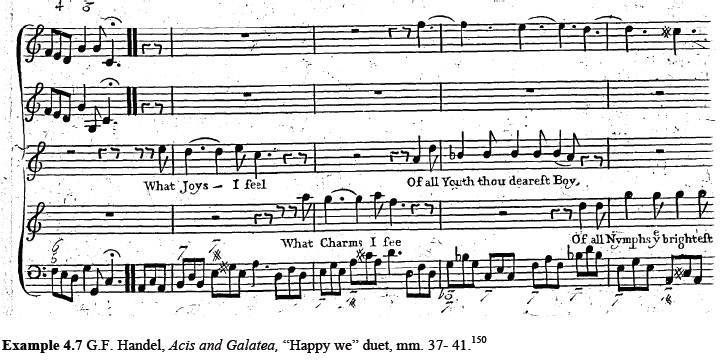 Lastly, in the final measures of the chorus, Mendelssohn augments measures 53 and 32―creating harmonic tension across the ensemble as shown in Examples 4.8 and 4.9. He newly composes music in measures53 through 57 and tacks on a kind of petite reprise, which in the French Baroque practice included repetition of the final phrase of music. 最後に、合唱の最終小節で、メンデルスゾーンは、例4.8と4.9に示すように、アンサンブル全体に調和張力を作り出す第53小節以降を追加した。彼は新たに53から517の小節で音楽を作曲し、フランスバロックにおいて行われるような、音楽の最終局面の繰り返しを試みた。 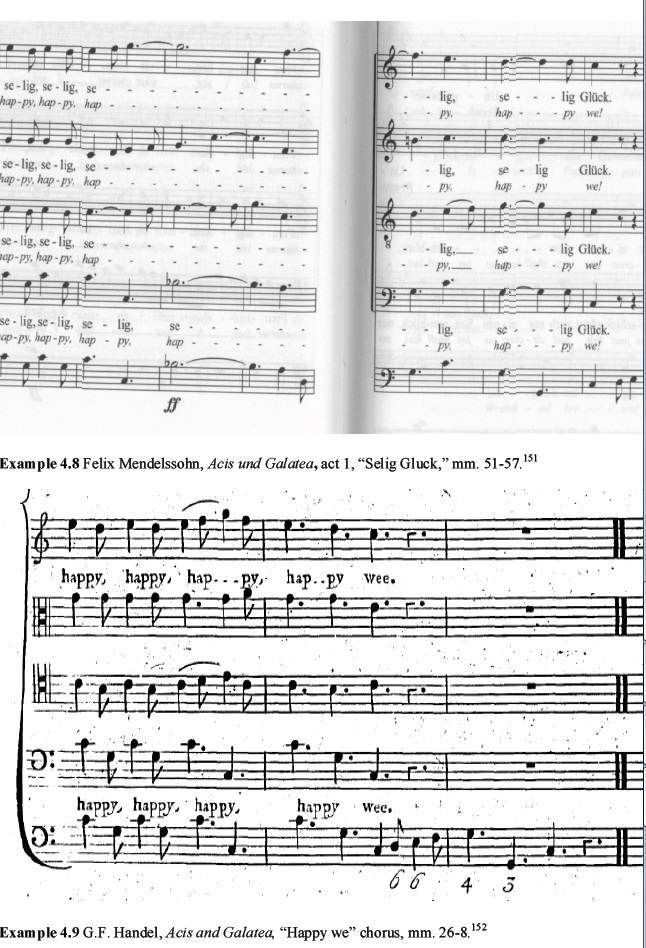 One plausible reason for altering Handel’s score in this ways is Mendelssohn wanted to capitalize on the excitement of the chorus, so he extend the final measures. In this case, Mendelssohn’s inserting an augmentation of the penultimate cadence simply delays the final cadence, which does occur in measures 38 to the end. In this case, inserting an augmentation of the penultimate cadence simply delayed the final cadence, which begins in measure 38. An example of how Mendelssohn alters the score without disturbing Handel’s pastoral mood comes from the first section of the opera. このようにHandelのスコアを変更する理由の1つは、Mendelssohnが合唱の興奮を生かしたかったためである。そして、彼は、最終小節を拡張したのである。この場合、メンデルスゾーンの最後から2番目部分の増加をするための挿入は、単純に最終カデンツを延長させるだけで、最後は第58小節となったのである。この場合、最後から2番目のカデンツを挿入するだけで、第58小節から始まる最後のカデンツも延期されたのである。メンデルスゾーンが、ヘンデルの牧歌的な雰囲気を乱すことなくどのようにスコアを変えるかの例は、オペラの第1幕から来ている。 The opening ritornello of Galatea’s aria with chorus “Muss ich dem Teuren Klage weihn” (“Must I my Acis still bemoan”) illustrates the way in which Mendelssohn alters the instrumentation by substituting or adding instruments while still preserving the character of the of aria as shown in Examples 4.10 and 4.11. 合唱 "Muss ich dem Teuren Klageweihn" (“Must I my Acis still bemoan”)を伴うガラテアのアリアのオープニングritornelloは、メンデルスゾーンが、例4.10と4.11に示されているように、アリアの性格を保持したままで楽器を代用または追加することによって器楽化するやり方を説明している。 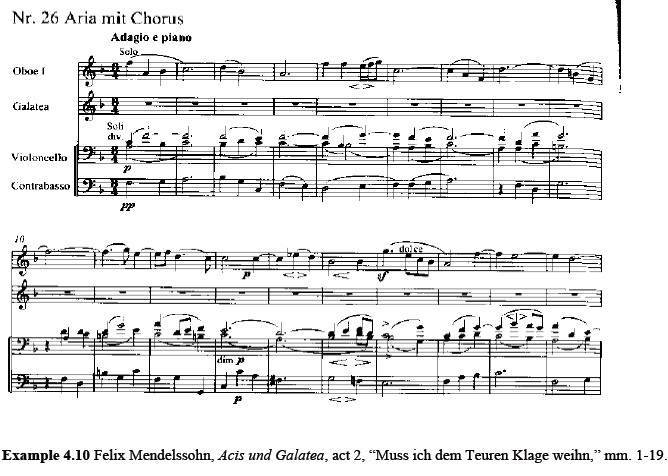 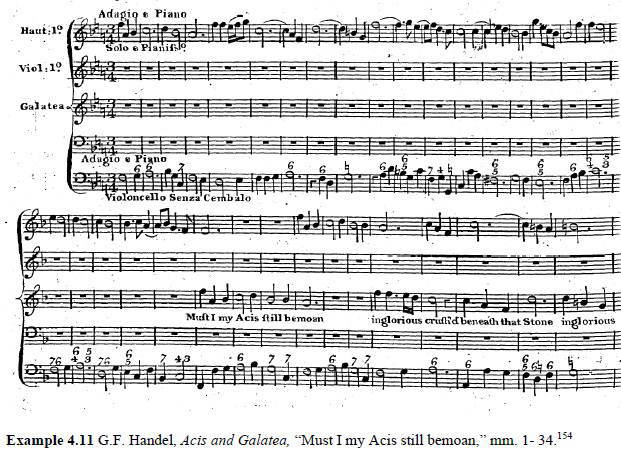 Here, Mendelssohn preserves the lyrical quality of the lower-voiced instruments, but takes Handel’s scoring for solo cello and oboe, adds an additional cello part and calls for the contrabass to double the cello II at the octave. The addition of the countermelody in the first cello part functions as a filler in the middle register. While this has the potential of saturating the lower parts, the polarity of the violins and cello heard in Handel’s score carries over to Mendelssohn’s score. Perhaps slightly more than in the Cannon’s score, this opening section echoes the previous trio as it divides evenly among the solo oboe, solo cello, and functional bass lines. The result is a cascade of suspensions across all parts. ここでは、メンデルスゾーンは低音の楽器の叙情的な質を保つが、ヘンデルのソロ・チェロとオーボエのスコアに対して、追加のチェロパートを追加し、コントラバスには、オクターブでチェロIIをオクターブ下で支えるよう指示している。 第1のチェロ部のカウンターメロディーの追加は、中央部位の音域のつなぎとしての機能を持っている。これが低音部位を満たすポテンシャルを持っている間、ヘンデルのスコアで聞かれるヴァイオリンとチェロの対照性はメンデルスゾーンのスコアにも引き継がれている。 おそらく、Cannon版よりも若干多く、このオープニングセクションは,以前のトリオがソロ・オーボエ、ソロ・チェロ、機能的なバスラインの間で均等に分割されているように響く。 その結果、すべてのパートにまたがる稽留音が出現してくる。 In “Schweig, oh luft’ger Sangchor,” (“Hush, ye pretty warbling quire”), Mendelssohn alters the meter, adds to the orchestration, and changes the substantive musical material, especially the rhythmic pattern seen in Examples 4.12 and 4.13. This is a major change from the Handel score. First, Mendelssohn changes the meter from 9/16 to 3/4 with a triplet figure throughout, which visually appears as 9/8. Next, Mendelssohn substitutes a flute for soprano recorder used the 1718 score. Just as Handel offered his audience a clue to the Affekt of the “warbling quire” in Galatea’s inaugural aria, Mendelssohn preserves the aviary imagery of the flute obbligato in the upper string parts. Instead of the flourish of ornamentation once found in the recorder part, Mendelssohn replaces it with a repetitious flow of compound eighth notes in the violin parts. This, in turn, alters the decoration in the top treble part; however, Mendelssohn succeeds in preserved the jig character in the top two violin parts by keeping using the triplet motive throughout. Moreover, the wind instruments, including paired flutes, clarinets, bassoons, and horns play sustained chords above the now string-dominated compound eighth-note motive in measures 1-9. The opening ritornello in measures 11-15 begins with a cascade of color first in paired flutes, then in paired clarinets, ending with bassoon, cellos, and double bass. 「Schweig、oh luft'ger Sangchor」(「Hush、ye pretty pretty warbling quire」)においては、Mendelssohnは音律を変え、オーケストレーションに加え、実質的な音楽素材、特に例4.12と4.13に見られるようなリズムパターンを変えている。これは、ヘンデルのスコアからの大きな変化である。最初に、メンデルスゾーンは拍子を9/16から3/4に変え、視覚的には9/8と表示されている。次に、メンデルスゾーンは、1718年版のスコアを使用したソプラノ・レコーダーをフルートに代えている。メンデルスゾーンは、ガラテアのアリアで、ヘンデルが聴衆に“warbling quire” のAffektへの手がかりを与えたように、弦楽器パート内にフルート・オブリガートの鳥のイメージを残している。 Mendelssohnはリコーダーパートにある装飾の代わりに、ヴァイオリンのパートで8分音符の繰り返し音符を繰り返している。これは、次に、高音部分の装飾を変更する。しかし、メンデルスゾーンは、全体で三連符の動機を使い続けることで、バイオリン2声パートのジーグ的性格を保存するのに成功している。さらに第1~9小節において、2本のフルート、クラリネット、バスーン、ホーンなどの木管楽器は、八分音符から成っている弦楽器が支配的な部分上を、持続的和音で奏でている。第11-15節のリトリネロのオープニングは、最初にペアのフルートの音色の下降音型で始まり、次にペアリのクラリネットで、最後はバスーン、チェロ、ダブルベースで終わる。 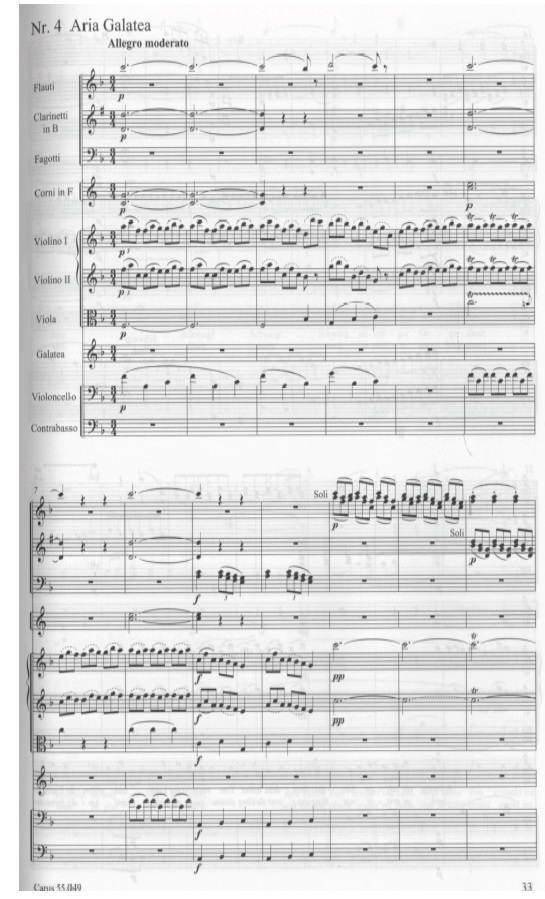 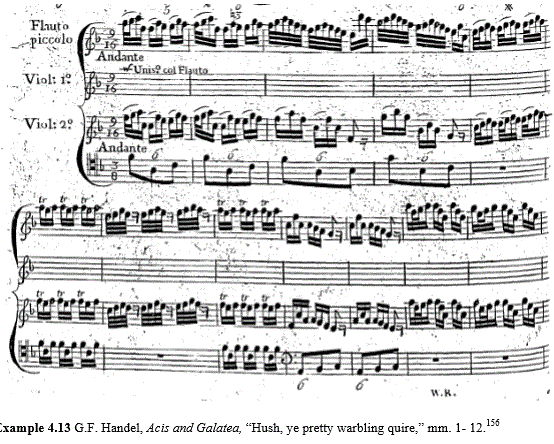 As the cadence approaches in measure 17, Mendelssohn makes a final statement with a solo flute line in an ascending arpeggio. This figure is not included in Handel’s score. As Mendelssohn adds wind parts, much of the inner harmony implied in Handel’s 1718 score in the basso continuo is transcribed to the wind parts.157 Finally, there are two examples of changes in musical markings―both used in decoration and articulation. In the ritornello, specifically measures 6, 11, and 14, Mendelssohn adds trills to the obbligato, further advancing the bird-call sound. The other instance is the addition of staccato markings in the flute part found in measures 13 through 14. Both indications might be transcribed from Handel’s score when the soprano recorder part changes from one that imitates vocal melismas to one that is more punctuated decoration in measures 23, through 26 in Handel’s score. While much more can be offered in analysis of this movement, the general impression is this aria is one of the most significant reorchestrations in all of Mendelssohn’s adaptation of Acis and Galatea. An example of another remarkable change in Handel’s score is the recitativo accompagnato in the second part of the opera. 第17小節でカデンツが近づくにつれて、メンデルスゾーンは,上昇するアルペジオのソロ・フルートで最後の音形を作成する。この部分は、Handelのスコアには含まれていない。メンデルスゾーンが木管楽器パートを加えると、basso continuoのヘンデルの1718年のスコアに暗示されている内声の多くは、木管楽器パートに実際に転写されている.157 最後に、decoration とarticulationの両方で使用される音楽記号の変化の例が2つある。リトネルロでは、特に第6、11、14小節で、メンデルスゾーンはオブリガートにトリルを加え、鳥の呼び声をさらに進めていく。もう一つの例は、第13-14小節のフルートパートにスタッカート記号を付け加えたものである。両方の表示は、ソプラノ・リコーダーパートが、声楽メリスマを模倣する部分から、ヘンデルのスコアで第23-26小節のより区切られた装飾がされている部分に変化する時に、ヘンデルのスコアから転写されたのかもしれない。この楽章の解析では多くのことが俎上に上ってくるが、このアリアの一般的な印象は、メンデルスゾーンの「Acis and Galatea」のあらゆる改訂の中ではもっとも重要なアレンジの1つである、ということである。ヘンゼルのスコアのもう一つの顕著な変更の一例は、第2部のレシータティボン・ソプラニャートである。 157 Poensgen,“ Foreword,” III. Since Mendelssohn worked from one of the first published scores (1742), we assume the change to include a final chorus of the first part was included in that score. It was not originally the composer’s intention to have a subsequent chorus. This was added in 1732 to expand the work slightly, making it a two-act opera. メンデルスゾーンが1743年版を利用したために、第1部の最後の合唱を含む変更は、その時のスコアを利用したとしか考えられない。連続する合唱を置くことは、作曲者の元々の意図ではなかった。この部分は1732年に、作品を2部構成にして、若干拡大するために付け加えられた。 At the end of the trio “Den Berg vilest die Herder,” (“The flocks shall leave the mountains”) Mendelssohn writes an attacca into Acis’s recitative accompaniment “Hilf Galatea” (“Help Galatea”) as shown in Examples 4.14 and 4.15. The heightened sense of action is succeeded at this point by a drum-roll signifying “the death of Acis in a particularly dramatic way.”160 While Acis continues singing in his final recitativo, the Affekt of the orchestral descending line, the timpani roll across the page and the sforzando piano on the opening chord focuses the attention on the murder and impending death of Acis. Mendelssohn adds two flutes, two clarinets, viola, and timpani to Handel’s scoring and alters not only the dynamic markings, but also the articulation markings and rhythmic notation. In measure 3, the rhythm in the string parts is meticulously notated as a series of sixteenth-notes and sixteenth rests, played within a pianissimo with a staccato articulation. Compared to Handel’s score, the change to sixteenth notes and a double-piano dynamic marking hones in on the slow, fading away of Acis’s life as he pleads, “Ye parent Gods and take me dying to your deep abodes.” The final flourish of rhetoric Mendelssohn adds to the score is a trill on the penultimate note of the movement, the leading tone of the scale. In all, this recitativo encapsulates the spectrum of changes Mendelssohn makes throughout the score. トリオ“Den Berg vilest die Herder,” (“The flocks shall leave the mountains”) の終わりで、メンデルスゾーンはAcis’s recitative accompaniment “Hilf Galatea” (“Help Galatea”)へのattaccaを書いた。(Examples 4.14 and 4.15) この時点で、「Acisの死は特に劇的な方法で死ぬ」ことを意味するドラムロールによって、この時点でアクションの高揚感が引き継がれている。160 Acisは最後のレシータティオで歌い続けているが、オーケストラの降下ラインのAffekt、スフォルツァンドのピアノは、Acisの殺人と死に至ることに注目している。メンデルスゾーンは、ヘンデルのスコアに2つのフルート、2つのクラリネット、ビオラ、ティンパニを加え、ダイナミックなマーキングだけでなく、アーティキュレーションのマーキングやリズムの表記を変えている。第3小節では、弦楽器パートのリズムは、16分音符と16分休符の連続として細心の注意が払われており、スタッカートで,ピアニッシモで演奏される。ヘンデルのスコアと比較して、16分音符とピアニッシモへの変更は、“Ye parent Gods and take me dying to your deep abodes.” と彼が訴えるようなAcisの命がゆっくりと失われていく過程である。メンデルスゾーンがスコアに加えた最後の華々しい修辞は、楽章の最後から2番目の音符のトリルである。全体として、このrecitativoは、メンデルスゾーンがスコア中にほどこした変更のスペクトラムを凝集したものと言えよう。 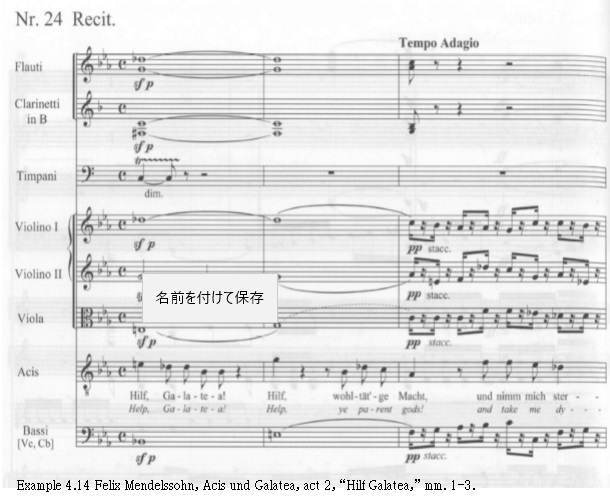 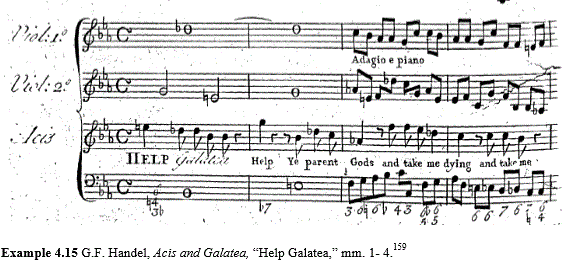 Of the arias that are most like Handel’s, Damon’s aria, “Junger Hirt, du suchst vergebens” (“Shepherd what art thou pursuing”) is orchestrated almost identically as Handel’s scoring with only strings. Other than Mendelssohn’s omission of the oboe colla parte with the first violin part, and the addition of a viola line, which Mendelssohn adds throughout the entire work, the aria is nearly identical to the Cannon’s score. The absence of reorchestration is further amplified by his being overly cautious about musical markings. Other than the occasional editorial dynamic marking of piano during the vocal solo and forte during the orchestral interjection, there is little to be exposed. Perhaps, this is a fine example of a movement that received editorial oversight from Mendelssohn. His efforts to leave some movements untouched is evident with this aria, but there remains a general comment about the overall score. ヘンデルのDamonのアリアJunger Hirt, du suchst vergebens” (“Shepherd what art thou pursuing”)は、ヘンデルが弦楽器だけで作曲したのとほぼ同一のままにオーケストレーションがなされたものである。メンデルスゾーンが、第1ヴァイオリンとcolla parteで演奏するオーボエの省略、ヴィオラの追加をした以外は、このアリアは Cannon版のスコアとほぼ同じである。 再オーケストレーションがない影響は、メンデルスゾーンが音楽記号について過度に慎重であることによってさらに増幅されている。ソリストが歌う間のピアノとフルオーケストラのフォルテの強弱記号の記入以上のことはなされていない。おそらくはこれは、メンデルスゾーンから見落とされた楽章の好例である。いくつかの楽章をそのままに残しておいた彼のやり方は、このアリアで明らかではあるが、スコアすべてについての一般的コメントが残っている。 One final note concerning a general change in the score is the addition in all of the recitatives instrumental parts for instruments not considered typical basso continuo instruments. Throughout Mendelssohn’s adaptation, both dry and accompanied recitatives are realized. For the accompanied recitatives, Mendelssohn adds woodwinds, brass, and even timpani. The effect of having strings play on every movement throughout the work provides a continuity of sound. Furthermore, with the strings filling in the harmony above the bass parts on a majority of the recitatives, the role of the keyboard and basso continuo instruments becomes less important. As we would expect in an early nineteenth-century adaptation, the use of basso continuo no longer applies to the conventional practice of that century.161 In short, the sum of the Mendelssohn’s adaptation is that the sound is fuller from the briefest of musical ideas to the longest of choruses. スコアの一般的な変化に関する最後の1つの注記は、典型的なバッソコンティニュオ楽器とはみなされない楽器のための、レシタティーボ楽器パートの追加である。 メンデルスゾーンの編曲を通して、朗読のみのレシタティーボと伴奏付きレシタティーボの両方が理解される。 伴奏付きレシタティーボのために、Mendelssohnは木管楽器、金管楽器、さらにはティンパニさえも加えている。 楽章中のあらゆる動きに弦を演奏させることの効果は、作品中に音の連続性を供給する。さらに、レシタティーボの大部分にバスパート上に和音を満たす弦楽器とともに、鍵盤楽器とバッソコンティニュオ楽器の役割はより重要性を減じていくようになる。 我々が19世紀初期の改訂において考えたように、バッソコンティニュオの使用は、もはや従来のような実践には適用されない.要するに、メンデルスゾーンの改訂のすべては、そのサウンドが、音楽のアイデアの中で最も短いものから最長の合唱まで、より豊かであるということである。 Conclusion The legacy of this Mendelssohn’s adaptation is linked to the Bach Revival saga. For Mendelssohn, the impact Handel’s dramatic music had on his own output is immeasurable. When we consider Mendelssohn’s adaptation of this masque in light of his other adaptations, a clearer image of a young composer still in training emerges. In one way, these adaptations are a kind of teaching method, which positioned Mendelssohn in the middle of revivalism and adaptation. Furthermore, it caused him to manage the logistics surrounding a historical performance of one of Handel’s more popular works. This involved making an arrangement that mitigated the change in design of certain instruments, as well as instruments not at Handel’s disposal at the Cannons residence. Finally, Mendelssohn recomposed portions of the masque, perhaps to integrate his own musical ideas on the subject. In sum, Mendelssohn’s Acis and Galatea reflects all of these considerations, and the result is a musical score that sounds like one of Mendelssohn’s vocal works circa 1830. このメンデルスゾーンの編曲の遺産は、バッハ復興の伝統に関連している。メンデルスゾーンの場合、ヘンデルの劇的な音楽が自身の作品に与える影響は計り知れない. メンデルスゾーンのこの編曲が彼の他の編曲におよぼした影響を考えると、まだ訓練中の若い作曲家のイメージがより明確になる。。一つの方法では、これらの編曲は、メンデルスゾーンが復古主義と編曲の中間に位置付けられる教授方法の一種である、ということである。さらに、彼はHandelのより一般的な作品の歴史的な演奏を取り巻くマネージメントを行った。これは、Cannon時代のヘンデルを廃棄しない楽器同様に、ある種の楽器のデザインの変更もしないようにする編曲を含んでいる。最後に、メンデルスゾーンは、おそらくは主題への彼自身の音楽的アイデアを統合するために、マスクの一部を再作曲した。要約すると、メンデルスゾーンの「Acis and Galatea」は、これらのすべての考慮事項を反映しており、1830年頃のメンデルスゾーンの合唱作品として結実している。 Chapter 5 Conclusion Mozart’s and Mendelssohn’s adaptations of Acis and Galatea are representations of Handel’s music at a later point in time. They are attempts at making older music viable in a more contemporary performing context. By updating this masque, Mozart and Mendelssohn offer alternate approaches to performing Acis and Galatea beyond its original historical and performance context. Each adaptation offers a unique perspective into the performance practices of the 1780s and the 1830s. In the twenty-first century, audiences have a multiplicity of options on how they choose to consume live performances of early music. モーツァルトとメンデルスゾーンの「AcisとGalatea」の編曲は、後の時点でのHandelの音楽の表現であるといえる。それらは、より当代的な演奏内容でより古い音楽を生き生きとさせる試みである。 このマスクを更新することにより、MozartとMendelssohnは元々の歴史的およびパフォーマンス的内容を超えて、「AcisとGalatea」を演奏する交互のアプローチを差し出している。それぞれの編曲は、1780年代と1830年代のパフォーマンス実践について独自の視点を提供している。 21世紀には、聴衆は初期の音楽の生きた演奏ををどのようにして消費するかという選択の多様性を持つことだろう。。 With Handel’s Acis and Galatea and the subsequent adaptations, there is a unique opportunity to explore performance practice as a case study. The differences among the adaptations offer a glimpse at how each composer approached the performance of Handel’s music. These alterations, in part, reflect the evolution of performance practice throughout the eighteenth and nineteenth centuries. In terms of musical markings, there are two kinds. The explicit kind is readily identified in the score, but the implicit markings―those that supersede the necessity for an indication―including decorations, minute changes in dynamic levels, agogic text stress, and improvisation of any kind. Performing music with any performance practice in mind is more than understanding the implicit musical markings. Nevertheless, an implied performance practice is guided by familiarity with how the music was performed. Handelの「AcisとGalatea」とその後の改訂では、ケーススタディとして演奏実践を探求するユニークな機会がある。 この改訂の間の違いによって、各作曲家がヘンデルの音楽の演奏にどのようにアプローチしたかを垣間見ることができる。 これらの変化は、部分的には、18世紀と19世紀を通じて演奏実践の進化を反映している。 音楽のマーキングに関しては、2つの種類がある。 明示的な種類はスコアで容易に識別できますが、暗黙的な種類は、 装飾、動的なレベルの微小な変化、厄介なテキストストレス、そしてあらゆる種類の即興を含む表示の必要性に取って代わるものである。 演奏方法を念頭に置いて音楽を演奏することは、暗黙の音楽マーキングを理解すること以上のことである。 それにもかかわらず、暗示的な演奏実践は、音楽がどのように行われたかに精通することにより導かれる。 These later versions of Handel’s Acis and Galatea exist in a broader collective of works that have been adapted. Their arrangers sought to include this masque as part of a group of works that were being revived. In part because of the growing interest in presenting older music in the contemporary performance practice, Mozart and Mendelssohn made adaptations of Handel’s Acis and Galatea, and each one is simultaneously comparable and incomparable to Handel’s score. They are testament to the desire of individuals like van Swieten and Zelter, by way of choral societies, continued to present older music. They are both original compositions and arrangements of original compositions. They also are alternative approaches to how we can approach historically informed performance practice today. これらの後の版のHandelの「 Acis and Galatea」は、改訂された作品のより幅広いグループに存在している。 それらの編纂者たちは、復活された作品群の一部としてこのマスクを含めるように努めた。 モーツァルトとメンデルスゾーンは、Handelの「 Acis and Galatea」の改訂をし、それぞれが同時に、ヘンデルのスコアに匹敵し、比類のないものであった。 それらは、合唱団を通じて、古い音楽に続いていく、van Swieten and Zelterのような個人の希望の遺言である。 それらはオリジナルの作品とオリジナルの作品の編曲の両方である。 また、今日の歴史的な情報に基づいた演奏実践にどのようにアプローチできるかについての代替アプローチもある。 Moreover, these adaptations exist on an early-music-revival spectrum, even though they are products of an earlier time. The Mozart and Mendelssohn adaptations reflect an interest in the performance of older music. Their brand of early music performance is vastly different from the brand of today, but it is familiar with today’s brand because it desires an exploration of what has come before―even if the means to get there are different. As much as the early music movement has changed the way modern musicians approach there performance of early music, there is still a difference between a period performance and a modern performance. Performance practice is not a fixed idea. It continues to evolve in conjunction with contemporary music in ways never before experienced. さらに、これらの改訂はより早期の作品であっても、初期音楽の再生スペクトルに存在している。 モーツァルトとメンデルスゾーンの改訂は、古い音楽の演奏への関心を反映している。 初期の音楽パフォーマンスのブランドは今日のブランドとは大きく異なるが、そこに到達する手段が異なる場合であっても、これまでに来たものを探究への欲求であり、今日のブランドと同様である。 初期の音楽の動きが、現代の音楽家が初期の音楽のパフォーマンスにアプローチする方法を変えたように、古い演奏と現代の演奏の違いはまだある。 パフォーマンスの実践は固定された考えではない。 それは以前に経験したことのない方法で現代音楽と共に進化し続けている。 The discovery of how each composer addressed the music of Acis and Galatea with respect to the performance practices of his own time has offered fresh insight into the liquidity of performance practices and periodization. Their choice of instrumentation, the countermelodies they composed in order to incorporate additional instrument parts, the explicit rendering of articulation markings, and the pursuit of maintaining Handel's musical themes while incorporating their own musical ideas demonstrated their capacity to adapt older music. Historical authenticity and purism has only entered the discussion on historically-informed performance practice in the last century. For Mozart and Mendelssohn, it was the adaptation that equated the inequality between performance practices, all the while finding instances to integrate newer music with older. Therefore, performance practice is what is rendered from the adaptation, not the other way around. それぞれの作曲家が「AcisとGalatea」の音楽にどのように取り組んできたかの発見は、演奏実践と周期化の流動性の新鮮な洞察を提供した。 楽器の選択、追加の楽器パートを組み込むために作ったカウンターメロディ、アーティキュレーションマーキングの明示的なレンダリング、Handelの音楽テーマの維持を追求しながら、独自の音楽アイデアを取り入れることで、 歴史的な信憑性と純粋主義は、過去一世紀に歴史的に知らされた演奏実践に関する議論に入っただけである。 モーツァルトとメンデルスゾーンの場合、新しい演奏をより古いものと統合するための例を見つけながら、演奏実践の間の不平等を平等化にしたのが改訂であった。 したがって、演奏実践は、改訂から与えられたものであり、他のやり方ではないん。 The obligation of modern musicians who engage in performing early music in light of this movement is to integrate a historically informed performance practice alongside a contemporary performance practice. Such a vast history of performance practices is entirely unmanageable by musicians who are trained in a modern performance. Within the realm of historically informed performance practice, there are particular ways to approach music from various eras. Experts of each kind of performance practice approach music in a distinct way in order to convey the differences in musical styles. There is, of course, the third part of the model, which is, those musicians who play early music with some of the equipment and with some sensitivity to approach. For these musicians and the ensembles they make music in, historically informed performance practice is less absolute and more of a suggestion. I can find nothing wrong with this kind of an approach to early music, as long as it is understood to be but part of an approach towards the performance. この楽章に照らして初期の音楽を演奏する現代音楽家の義務は、現代の演奏実践に加えて歴史的に知られた演奏実践を統合することである。演奏実践のそのような広大な歴史は、現代の実践で訓練された音楽家によってでは、全く管理できない。歴史的に知られている演奏実践の分野では、音楽をさまざまな時代からアプローチする特別な方法がある。演奏実践の各種の専門家は、音楽スタイルの違いを伝えるために、音楽を別の方法でアプローチする。もちろん、モデルの第3の部分は、機器の一部で初期の音楽を演奏し、接近するための感度がある音楽家である。音楽を奏でるこれらの音楽家やアンサンブルのためには、歴史的に知られている演奏実践はより絶対的ではなく、より多くの提案である。初期の音楽へのこのようなアプローチは、演奏に向けたアプローチの一部であると理解されている限り、間違ったものは何も見つからない。 The future of the early music movement will continue to broaden expectations of musicians who perform early music and the work of this thesis is to add to the discussion of its usefulness and its application to other performance practice issues. The fundamental question remains, how is the music to be performed? Whether or not the instruments are historic, whether or not the performers are playing in a historically informed way, and whether or not the music has been edited revised or adapted, musicians distinguish their approach to performance practice among music from different eras. The Mozart and Mendelssohn adaptations change the way we look at performance practice because they blur the lines between period-specific performance practices. They offer options to performing Handel's Acis and Galatea and they expand the breadth of the early music movement. 初期の音楽活動の未来は、初期の音楽を演奏する音楽家の期待を広げ続け、そしてこの論文の仕事は、その有用性と他のパフォーマンス実践問題への応用についての議論に加えることである。 根本的な疑問は残っている。音楽はどのように演奏されるべきなのであろうか? 楽器が歴史的であるかどうか、演奏者が歴史的に情報を得た方法で演奏されているか否か、そしてその音楽が編集されたか改訂されたかどうか、音楽家は異なる時代の音楽の演奏実践にアプローチする。 モーツァルトとメンデルスゾーンの改訂は、我々が演奏実践を見るやり方を変える。。なぜなら、演奏実践は、特定の演奏実践の間の線をぼかすからである。それらは、Handelの「Acis and Galatea」を実践する選択肢を提供し、初期の音楽の動きの幅を広げるのである。 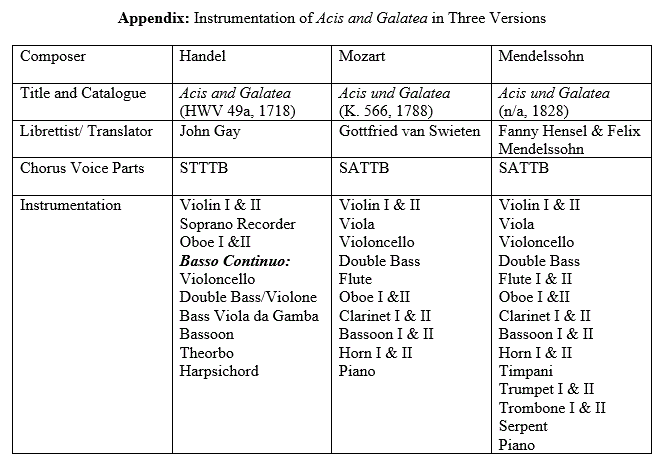 メンデルスゾーンの編曲では、レシタティーボは弦楽器を伴っている。 彼がすでにこの初期の編曲でオルガンやピアノを使用することを想定していたかどうかは、St. Matthew Passionnにおいてと同様に、、後に「エジプトのイスラエル人」と同様、ソースからは確認されない。。 確かにsecco recitativesには、continuo figure数字があるが、これは単純に弦楽器のハーモニーの連続チャートにすぎない。 |